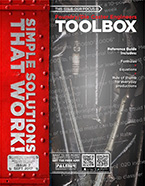Foundry & industrial processing Machinery EQUIPMENT & SYSTEMS
U.S. & Canada Call 1.800.457.5456
Molding Basics Mixer and Compaction Calibration
Home Articles Molding Basics Mixer and Compaction Calibration

Simple Solutions That Work!™, Volume 7, September 2017
By Palmer staff
Palmer Manufacturing & Supply, Inc.
Article Takeaways:
With this issue’s theme being a back-to-basics approach, we have focused on some simple items that are often overlooked as not being as important as they are. Without having these fundamentals in check, production issues downstream will certainly ensue. We will cover:
- Sand Calibration
- Resin Calibration
- First and Last Sand
- Compaction Force - Drop & Stop
Sand Calibration
Mixers use either a sand slide gate or a sand dam gate to control the amount of sand delivered to the mixing chamber. Slidegate – On mixers equipped with a sand slidegate, the sand slidegate’s air cylinder slides a steel “gate plate” with a hole drilled through it directly underneath the mixer’s sand inlet. This allows sand to flow through the gate plate hole into the mixing chamber. The diameter of the gate plate hole determines how much sand enters the mixing chamber and ensures that this amount is consistent, cycle after cycle. The following table shows an approximate relationship between the diameter of the sand slide gate plate hole and the amount of sand per minute entering the mixing chamber (actual volume may vary, depending on grain type and fineness).
Dam Gate – On articulated mixers equipped with a sand dam gate, an adjustable gate at the inlet end of the sand delivery conveyor controls the amount of sand flowing under the gate to the mixing chamber. Raising the gate increases sand volume; lowering it decreases volume. In the case of a mixer that has a dual speed belt to achieve high and low sand flow rates, it should be set up so that the high rate is at full belt speed and the dam is adjusted to deliver the desired high sand level. For the low rate, the gate should be kept in the same position and the speed of the belt reduced via the Variable Frequency Drive to deliver the desired low sand level.
Resin Calibration
After determining the pounds/minute of sand to be delivered to the mixing chamber, the next step is to determine the proper amount of resin to be delivered to the chamber as well. Do this using the recommended resin/pound percentage – for example, “1.5% per pound/minute” – available from your resin supplier.
To translate the resin percentage into a resin amount, multiply this percentage by the pounds of sand/minute. For example, if the resin percentage is 1.5% for 80 pounds of sand per minute, the resin amount is 1.2 pounds per minute (0.015 x 80 = 1.2).
Before beginning resin calibration, determine the proper amount for each resin (typically Part I and Part II) to be used in production operations, also available from your resin supplier.
Optional third-part resin – If your mixer includes an optional third pump used to supply the catalyst for a three-part resin system, also determine the proper third-part resin amount. Typically, this is a percentage of the part-1 and/or part-2 liquid total.
- Locate an empty container suitable for holding the amount of liquid you expect the mixer to process during calibration.
- Weigh the container selected using an appropriate calibration scale.Note this weight for later use.
- Place the container level with or above the mixing chamber’s inlet ports.
Note: It is important that the container is level with or above the inlet port. If the container is below the port, liquid can run out of the hose before and after the calibration test, which can dramatically affect accuracy. - On the mixing chamber, remove the liquid delivery jet of the liquid supply you are calibrating.
- Place the liquid delivery jet, nozzle pointing down, over the calibration container.
- If the mixer is equipped with a Calibration Timer, start the timer now and catch the resin that is ejected from the nozzle. If the mixer does not have a calibration timer, it is best to have a helper use a stopwatch and run the selected pump for a specified amount of time (1 minute is best, but a shorter time can be chosen in order to avoid resin waste)
- Weigh the container of resin and subtract the weight of the empty container weighed previously.
- If the amount dispensed matches the amount desired, the mixer is ready for production. If the amount does not match the amount desired, adjust the speed of the pump and retest until at desired range. The method for adjusting pump speed will vary based on mixer age and manufacturer, but it is usually via a potentiometer or a PLC Touchscreen input. Refer to your specific mixer manual for detailed information.
- Repeat this process for each resin component.
First and Last Sand
Once properly calibrated, the sand from the middle of a cycle is usable, but operators will sometimes have issues with the first and last sand at the beginning and end of a cycle. In order to make this sand usable, we recommend setting up a board test and then making adjustments to the start/stop speed of your resin and/or sand to balance them. To perform a board test, obtain a long board, such as a 1’ wide strip of plywood 8’ long, and a helper. Start the mixer and catch the first sand out of the mixer at one end of the board. Move the board under the mixer discharge catching the sand from the mix cycle. Shut down the mixer in time so that the last sand discharge from the mixer will be on the opposite end of the board from the start point.
Set the board down and observe the sand:
- The sand should be a consistent color from beginning to end
- Dark areas indicate excess resin
- Loose, dry sand indicates lack of resin
- Most current mixers have On and Off Delay Timers for both Sand and Resin
- Adjust timers as necessary in order to get a consistent color/wetness of sand
- Some older mixers will utilize flow control valves on the slidegate cylinder hoses to control the speed of the slidegate to adjust sand start stop speeds. Open or close those valves as necessary to dial in the slidegate speed to achieve a consistent liquid/sand mix at the beginning and end of the cycle
- Also look at the consistency of the mixed sand. Some resin systems are more difficult to mix and will leave Resin Balls in the sand. With the board test, the presence of resin balls can be evaluated and used to help eliminate them through blade changes, etc.
Compaction Force–Drop & Stop
Many customers underestimate the importance of compaction during the molding process. Compaction will deliver a more dense, consistent, stronger mold. However, compaction should be quick and limited. Allowing your compaction table to run after optimal mold density has been achieved will often do more harm than good. Ideally, compaction time should stay consistent and brief. Force output should be varied based on the mold size. In order to determine an optimal setting for a specific mold on your systems, we recommend:
- Decide on a compaction time such as 5 seconds
- Fill the pattern with mixed sand
- Strike off the top surface
- Run a compaction cycle
- Pay close attention to how long it takes for the sand to drop and then stop settling
- Adjust force output of the vibrators and retest until the stop occurs just before your decided compaction time expires
- Note the desired force output to the specific pattern/mold and utilize that output setting for any future production of that specific mold
- A video example of this process can be seen here as a reference: Click Here to watch the Sand Compaction Video.
All of the above items are quite basic, but are fundamentally important to delivering consistent, quality molds, which will eventually help lead to consistent, quality castings.
Copyright © 2025 Palmer Manufacturing & Supply, Inc. | Terms and Conditions | Privacy Policy




